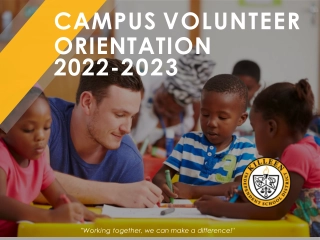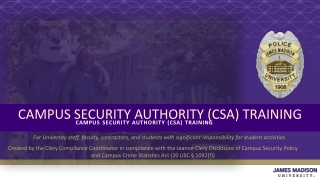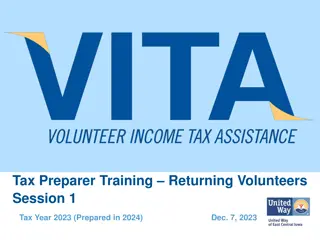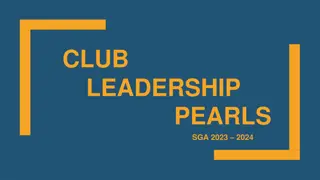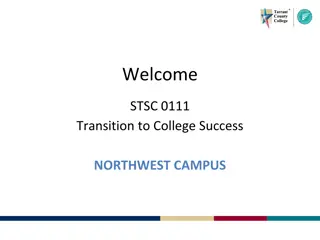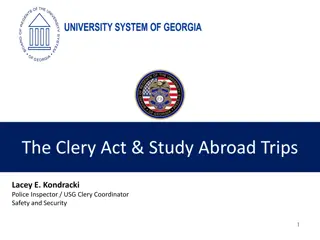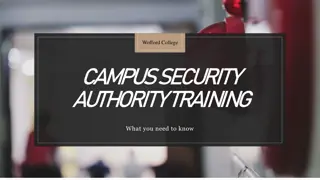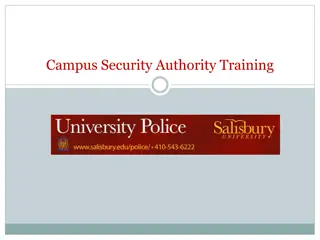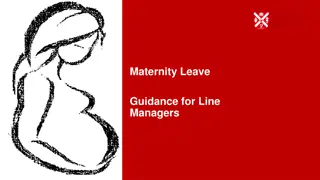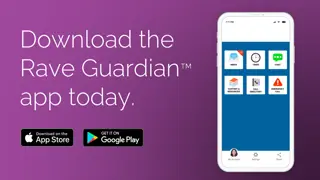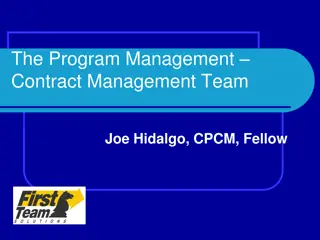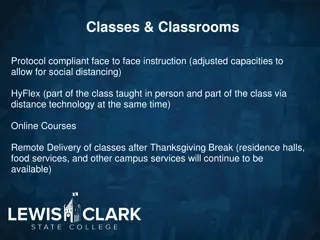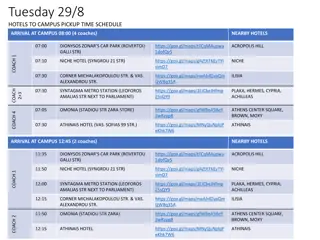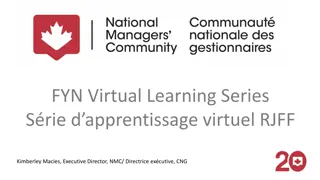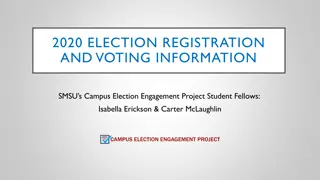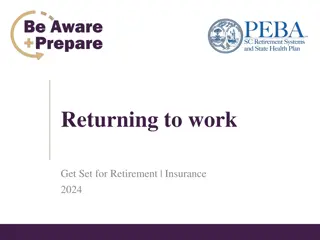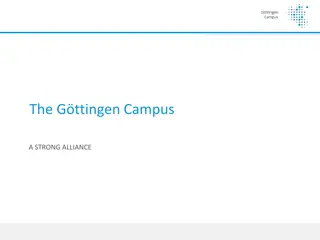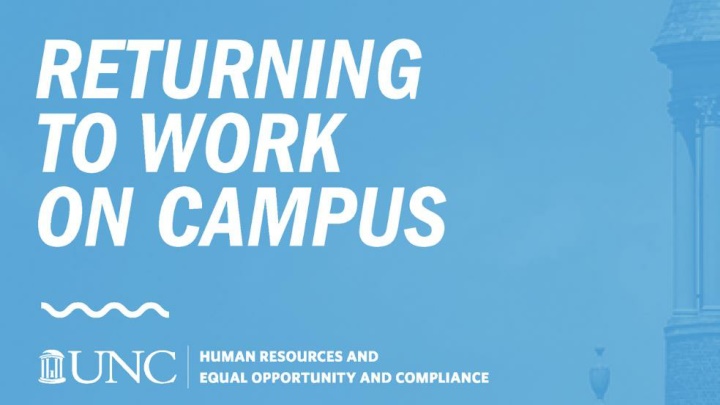
Workplace Safety and Health Guidelines for University Employees Returning to Campus
Learn about the information session goals and guidelines for university employees returning to work on campus in June 2021. The session covers health and safety standards, mental health considerations, parking logistics, and tips for managers. Explore the factors to consider for institutions where not everyone is fully vaccinated, along with COVID-19 vaccination coverage data. Additionally, discover the layered prevention strategies in place to reduce the spread of COVID-19 at the university. Stay informed to ensure a safe return to campus.
Download Presentation

Please find below an Image/Link to download the presentation.
The content on the website is provided AS IS for your information and personal use only. It may not be sold, licensed, or shared on other websites without obtaining consent from the author. If you encounter any issues during the download, it is possible that the publisher has removed the file from their server.
You are allowed to download the files provided on this website for personal or commercial use, subject to the condition that they are used lawfully. All files are the property of their respective owners.
The content on the website is provided AS IS for your information and personal use only. It may not be sold, licensed, or shared on other websites without obtaining consent from the author.
E N D
Presentation Transcript
Returning to Work on Campus Information Session for University Employees June 2021
INFORMATION SESSION GOALS We plan to share: Health/Safety and Community standards Mental health importance and considerations Parking/logistics and helpful resources Guidance and tips for managers/supervisors Questions and answers
Return to Campus: Workplace Safety Catherine Brennan Environment, Health & Safety
IHEs where not everyone is fully vaccinated: Requires decision making to protect the people who are not fully vaccinated. Multiple factors should inform the optimal implementation of layered prevention strategies. CDC Guidance for Institutes of Higher Education (IHEs) as of June 4, 2021 Primary factors to consider: 1. Level of community transmission 2. COVID-19 vaccination coverage 3. Implementation of a robust, frequent SARS- CoV-2 screening testing program with high participation from unvaccinated campus population 4. Any local COVID-19 outbreaks or increasing trends
North Carolina daily percent positive rate = 2.7% Level of Community Transmission (06/28/21) Orange County 14-day percent positive rate = 0.5% Carolina Together Testing Program since June = 0.04% UNC Student positives since June 1st, 2021 = 2 UNC Employee positives since June 1st, 2021 = 3
COVID-19 Vaccination Coverage Area % Total % Adults Fully Vaccinated % Total Population Partially Vaccinated 54 45 64 % Adults Partially Vaccinated Population Fully Vaccinated United States North Carolina Orange County 46 42 62 56 52 - 66 55 - Employee self reports = 27% Vaccination status is never shared with supervisors or departments using for a broad picture of campus rate Assume that we are somewhere around 50% https://ehs.cloudapps.unc.edu/ClinicRegistration/covidcert
LAYEREDPREVENTIONSTRATEGIES REDUCESPREAD UNC Health Friday Center Clinic (until 07/31/21) Available on campus at Campus Health Student Stores Pharmacy Students must attest to vaccination status as part of registration for Fall Students, Faculty and Staff are encouraged to self-report vaccination Designated leave provisions to obtain vaccine or to deal with side effects Consistent and correct use of masks Mask mandate inside all University buildings (more conservative than state, county or town) Physical distancing Promoted through signage Handwashing and respiratory etiquette Promoted through signage Enhanced cleaning of bathrooms to stock soap and paper towels Hand sanitizer stations Offering and promoting vaccination
LAYERED PREVENTION STRATEGIES REDUCE SPREAD Contact tracing in combination with isolation and quarantine Campus Health for students UEOHC for employees Testing for COVID-19 Surveillance testing via Carolina Together Testing Program Symptomatic students can go to Campus Health for testing Employees should contact primary care provider for access to testing Maintaining healthy environments (increasing ventilation and cleaning) Facilities Services has implemented enhanced cleaning procedures Facilities Services has upgraded building box filters to MERV 13, ensured building HVAC systems are performing as designed, increased air rates when possible Maintaining healthy operations (communications, supportive policies, and health equity) Carolina Together, individual depart/unit COVID websites, etc.
TIPS FOR WORKPLACE SAFETY Vaccination is the best way to prevent COVID-19 transmission Follow UNC community standards when at the workplace You can always be more conservative than community standards Guidance changes based on current trends so continue to closely follow updated UNC guidance
MENTAL HEALTH: IMPORTANCE AND CONSIDERATIONS FOR RETURNING TO WORK ON CAMPUS -- the Role of Mindfulness, Compassion, and Good Communication Susan A. Gaylord, PhD Program on Integrative Medicine | UNC Center for Mindfulness Department of Physical Medicine and Rehabilitation | School of Medicine
LEARNING OBJECTIVES Importance of recognizing hardship, and need to exemplify kindness/compassion/understanding A mindfulness tool Breathing space -- for enhancing positive experience of staff in transition Mindful communication tips for having empathetic conversations.
THESE ARE UNPRECEDENTED TIMES: Life threatening pandemic Illnesses and hardships family and economic Racial turmoil Mass shootings Global warming
Stress: the emotional and physiological reaction to any event(s) that the organism finds emotionally and/or physically challenging. All of these events have caused stress and perhaps even trauma, on a large scale Chronic stress: can lead to anxiety, sleep disturbance, poor coping (e.g. binge eating, substance abuse) depression, illness, and burnout
RETURN TO WORK ON CAMPUS: Requires adjustment for all of us. Physical adjustment Psychological adjustment Recognize that for all of us This new event can trigger trauma e.g. childhood fears for safety Fear of illness Uncertainties about safety: e.g. COVID threat, the environment, other people s behavior, Concerns of childcare and pets, scheduling, changes in routines We are in this TOGETHER
ON THE OTHER HAND.RETURNING TO WORK ON CAMPUS: Could be a source of relief e.g., returning to familiar work environment, renewing friendships with colleagues Increase peer support (for those who have been isolated), Increase social connections Increase economic certainty. Again we are in this TOGETHER!
Recognize and empathize with hardships. Be open in expressing and sharing concerns. Acknowledge the importance of self-care and appreciate and support employees efforts towards self-care. Acknowledge uncertainty and continued change. Be sensitive to possibilities of trauma and psychological distress. Be flexible whenever possible. Show compassion. Show kindness (including random and non- random acts). Have a good sense of humor. As managers, we can make a tremendous difference in employees experience of returning to work:
Resilience is the process of adapting well in the face of adversity, trauma, tragedy, threats or significant sources of stress, "bouncing back" from difficult experiences, has shown to increase with mindfulness. Mindfulness can increase the potential for awareness, sensitivity, compassion and resilience: Mindfulness also decreases sense of isolation, depression, and burnout. Mindfulness improves ability to regulation emotions and have empathy (real caring for self and others) as well as enhance insight and creativity.
BREATHING SPACE 1. Aware of what is here in this moment body sensations; emotions; thoughts no need to judge or change anything. 2. Redirect attention to breathing Use breath as anchor to present moment awareness. 3.Expand field of awareness body, emotions, thoughts, environment. soften and allow what is. Whatever it is, it s okay, I can deal with it.
MINDFUL LISTENING AND COMMUNICATION Find a quiet place. Listen fully, without judging or interrupting. Notice if you are distracted, and come back to being in the present moment. Notice if you are being impatient, or just waiting for your turn to speak. You can practice mindful communication with colleagues. Set a timer for at least 10 minutes for each person. First, do breathing space, then practice mindful listening. Take turns, and debrief about how it felt and what you heard. (Alternative, be in circle, with a talking stick )
SELF-COMPASSION/LOVING KINDNESS In your own words, you can say these affirmations: May I be happy How to be your own best friend: For whatever situation you find yourself, imagine giving words of consolation, as if you were your own best friend. May I be healthy May I be safe May I be at peace. May they be happy May they be healthy May they be safe May they be at peace.
FOR FURTHER INFORMATION: Program on Integrative Medicine/The Mindfulness Center at UNC website: https://www.med.unc.edu/phyrehab/pim/mindfulness- program/mindfulness-course-schedule/pim.med.unc.edu
PARKING AND TRANSPORTATION July 19-31 2021-22 Academic Year Parking Accommodations Parking permits available Academic year permits begin on August 1 Department Parking Coordinator to assign Will be able to use payroll deduction Flex rate available if on campus 3 days/week or less Transportation and Parking Accessibility Committee (TPAC) considers requests for accommodations, including inability to use public transit due to COVID Applications considered twice a month and link available here: https://move.unc.edu/parking/ accessibility/medical-mobility- form/ Parking Information Have to log in and pay online Flex rate available if on campus 3 days/week or less Contact Department Parking Coordinator to request Non-parking alternatives include Chapel-Hill transit, Chapel Hill and Carrboro buses, and University park-and-ride lots.
ACCOMMODATIONS Eligibility Documentation Timing Change from previous accommodations: Must submit complete medical documentation form from a provider Employee s responsibility to ensure sufficient medical information is provided Ask that all requests be submitted three weeks prior to return (June 28) Reviewing weekly on an as- received basis If received after June 28, may need to do a temporary accommodation Employees who are unable to be vaccinated due to disability; Employees who have a Accommodation s disability that continues to require accommodation after being vaccinated; or Employees who are unvaccinated and have a disability impacted by COVID Only health needs of the employee
RESOURCES ITS EAP EMR Manager Assistance reactivating campus workstations Assistance GuidanceResources EAP Service (24 hours a day) EAP Counselors can help with: Depression and anxiety Workplace concerns Grieving the loss of a loved one Managing change and personal stress Fear and anger associated with health problems Available to consult on employee concerns that arise during the return to campus Available to assist with identifying trainings and professional development that may be helpful to employee Recurring short- term arrangements (location, schedule) of 30 days or less due to special or unique circumstances Allow time for wellness resources and programming Other Resources reconnecting to campus internet/network Assistance reconfiguring phones Available now to meet on campus to ensure you re ready to go on July 19
GUIDANCE AND TIPS FOR MANAGERS Create an atmosphere of patience, kindness and empathy Encourage employees to discuss needs/feelings/concerns Potential team meeting topics Personal sharing/reacquaintance Discuss challenges/benefits/feelings about returning to campus/ new abnormal What aspects of work improved under pandemic conditions? What lessons can we bring forward to make work better? What do we want to do differently now?

